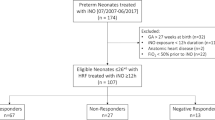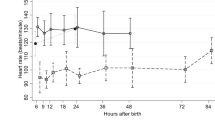Abstract
Objective:
We calculated in a referral population of term and near-term infants with hypoxic respiratory failure (HRF) as a primary presenting problem the overall survival rate, the need for extracorporeal membrane oxygenation (ECMO) and the incidence of apparently irreversible disorders.
Study Design:
All infants ⩾36-week gestation admitted at ⩽72 h of age from 2000 through 2005 were identified. The worst (highest) oxygen index (OI) was calculated and outcomes were noted.
Results:
A total of 630 infants were reviewed and 315 infants were identified with primary diagnosis of HRF; four infants died before discharge. One hundred seventy-seven infants had OI ⩽14; 71 had OI of 15 to 25; and 67 had OI of >25. A total of 32 infants received ECMO, including all four who died, two with histologic evidence of pulmonary malformations and two with septic shock.
Conclusion:
Term or near-term infants with isolated HRF are likely to survive, given the low incidence of pulmonary disorders not supportable by inhaled nitric oxide or ECMO.
This is a preview of subscription content, access via your institution
Access options
Subscribe to this journal
Receive 12 print issues and online access
$259.00 per year
only $21.58 per issue
Buy this article
- Purchase on Springer Link
- Instant access to full article PDF
Prices may be subject to local taxes which are calculated during checkout
Similar content being viewed by others
References
Angus DC, Linde-Swirble WT, Clermont G, Griffin MF, Clark RH . Epidemiology of neonatal respiratory failure in the United States. Am J Respir Crit Care Med 2001; 164: 1154–1160.
Committee on Fetus and Newborn. Levels of neonatal care. Pediatrics 2004; 114: 1341–1347.
Kinsella JP, Truog WE, Walsh WF, Goldberg RN, Bancalari E, Mayock DE et al. Randomized multicenter trial of inhaled nitric oxide and high- frequency oscillatory ventilation in severe persistent pulmonary hypertension of the newborn. J Pediatr 131; 1–8: 1997.
Truog WE, Castor CA, Sheffield MJ . Neonatal nitric oxide use: predictors of response and financial implications. J Perinatol 2003; 23: 128–132.
Thibeault DW, Haney B . Lung volume, pulmonary vasculature, and factors affecting survival in congenital diaphragmatic hernia. Pediatrics 1998; 101: 289–295.
Gardner MJ, Altman DG . Calculating confidence intervals for proportions and their differences Gardner and Altman. Statistics With Confidence. BMJ Press, London, 1989.
Kumar D, Super DM, Fajardo RA, Stork EE, Moore JJ, Saker FA . Predicting outcome in neonatal hypoxic respiratory failure with the score for neonatal acute physiology (SNAP) and highest oxygen index (OI) in the first 24 hours of admission. J Perinatol 2004; 24: 376–381.
Extra Corporeal Life Support (ELSO) Registry. Ann Arbor Michigan, 2007.
UK Collaborative ECMO Trial Group. UK collaborative randomized trial of neonatal extracorporeal membrane oxygenation. Lancet 1996; 348: 75–82.
Cochrane Neonatal Analysis. www.nichd.nih.gov/cochrane.FINER/imagePN4.JPG.
Neonatal Inhaled Nitric Oxide Study Group. Inhaled nitric oxide in full-term and nearly full-term infants with hypoxic respiratory failure. N Engl J Med 1997; 336: 597–604.
Davidson D, Barefield ES, Kattwinkel J, Dudell G, Damask M, Straube R et al. Inhaled nitric oxide for the early treatment of persistent pulmonary hypertension of the term newborn: a randomized, double-masked, placebo-controlled, dose-response, multicenter study. Pediatrics 1998; 101: 325–334.
Clark RH, Kueser TJ, Walker MW, Southgate WM, Huckaby JL, Perez JA et al. Low-dose nitric oxide therapy for persistent pulmonary hypertension of the newborn. Clinical Inhaled Nitric Oxide Research Group. N Engl J Med 2000; 342: 469–474.
Konduri GG, Solimano A, Sokol GM, Singer J, Ehrenkranz RA, et al., Neonatal Inhaled Nitric Oxide Study Group. Pediatrics 2004; 113: 559–564.
Guthrie SO, Walsh WF, Auten K, Clark RH . Initial dosing of inhaled nitric oxide in infants with hypoxic respiratory failure. J Perinatol 2004; 25: 290–294.
Gupta A, Rastogi S, Sahni R, Bhutada A, Bateman D, Rastogi D et al. Inhaled nitric oxide and gentle ventilation in the treatment of pulmonary hypertension of the newborn – a single-center, 5-year experience. J Perinatol 2002; 22: 435–441.
Acknowledgements
This work was presented in part at the Pediatric Academic Societies annual meeting, Washington, DC, 2005. The authors thank Mary S Bailey for her administrative assistance with this article and Susannah P Dillender, MD for her assistance with reviewing transport records. This study was supported in part by: Children's Mercy Hospitals and Clinics Physician Scientist Award, Sosland Endowed Chair in Neonatal Research and NIH R-01 70560 (WET).
Author information
Authors and Affiliations
Corresponding author
Rights and permissions
About this article
Cite this article
Truog, W., Kurth, G., Haney, B. et al. Hypoxic respiratory failure: etiology and outcomes at one referral center 2000 through 2005. J Perinatol 27, 371–374 (2007). https://doi.org/10.1038/sj.jp.7211753
Received:
Revised:
Accepted:
Published:
Issue Date:
DOI: https://doi.org/10.1038/sj.jp.7211753
Keywords
This article is cited by
-
Surf early to higher tides: surfactant therapy to optimize tidal volume, lung recruitment, and iNO response
Journal of Perinatology (2021)



